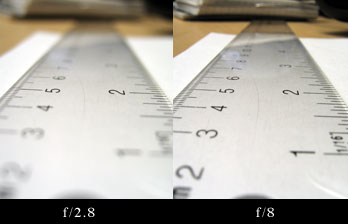
 |
Tutorials |
Aperture
tutorial -Article and photos by Dan
H.  This example shows the difference in openings of the aperture. The smaller the # the more light that is allowed to pass through. Aperture and it's effect on depth of field Another important aspect to aperture is that it also controls the depth of field or DOF. The smaller the aperture setting, the less depth of field and thusly the less area of acceptable focus.  Try this yourself. In this example, on the left, only the 2 is clearly in focus but not much else. On the right almost everything from the 1 to the 4 are in clear focus. In other words, if you want more of the image to be in focus, use a higher number of f/stop. If you want a very shallow depth of field, use a smaller number f/stop. |
This site was made, is maintained and is © 2011, all rights reserved by Dan Harper Photography. |